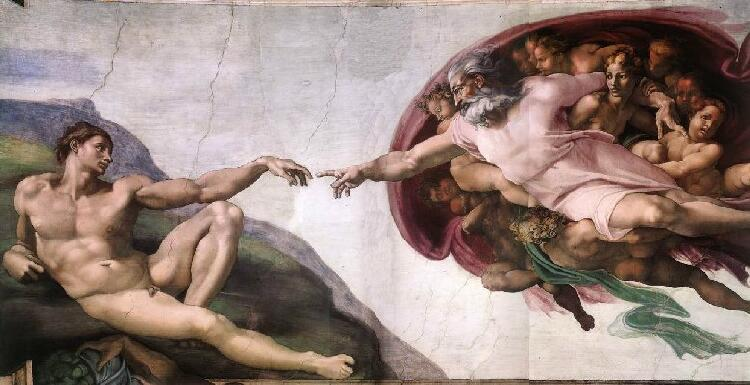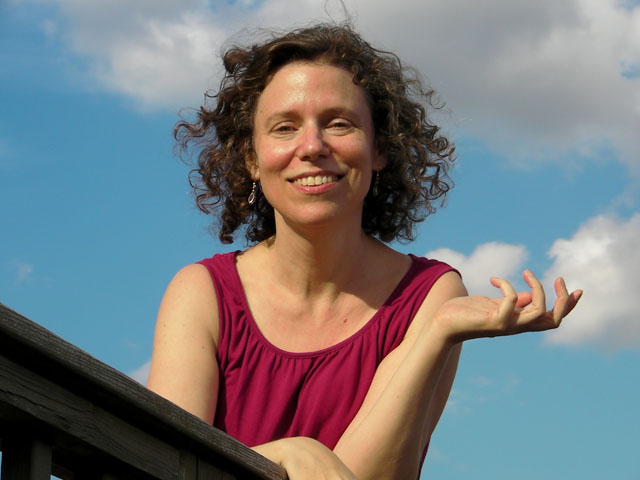My Cult of Originality essay gets a German translation, courtesy of Thomas Leske.

Ein kleiner illustrierter Aufsatz von Nina Paley. Sie lesen weiter.
Animator. Director. Artist. Scapegoat.
My Cult of Originality essay gets a German translation, courtesy of Thomas Leske.

Ein kleiner illustrierter Aufsatz von Nina Paley. Sie lesen weiter.
Our Idea
Which art in the Ether
That cannot be named;
Thy Vision come
Thy Will be done
On Earth, as it is in Abstraction.
Give us this day our daily Spark
And forgive us our criticisms
As we forgive those who critique against us;
And lead us not into stagnation
But deliver us from Ego;
For Thine is the Vision
And the Power
And the Glory forever.
Amen.
Many years ago, I thought “Mimi & Eunice” would be a great name for a comic strip. Recently I’ve been needing to do some drawing just to keep my head from exploding, so this week I figured, why not Mimi & Eunice?
As far as I can tell, Mimi & Eunice are two middle-aged children/baby psychos/heterosexual lesbians. That’s all I can surmise so far.  I didn’t put my name on these comics, but I did tag them with the URL mimiandeunice.com. (Unfortunately that site is a mess right now. Webmaster Ian installed the comicpress theme in wordpress, but it’s squishing the strips horizontally unless I make them really tiny. Also, even though it lets me bulk upload media, it doesn’t let me bulk post.
I didn’t put my name on these comics, but I did tag them with the URL mimiandeunice.com. (Unfortunately that site is a mess right now. Webmaster Ian installed the comicpress theme in wordpress, but it’s squishing the strips horizontally unless I make them really tiny. Also, even though it lets me bulk upload media, it doesn’t let me bulk post.
 So I’m just posting a bunch of them here, for now. If anyone out there makes great comics web sites and wants to make one Mimi & Eunice, please get in touch!)
So I’m just posting a bunch of them here, for now. If anyone out there makes great comics web sites and wants to make one Mimi & Eunice, please get in touch!)
 Other than getting mimiandeunice.com functional and pretty, I need to decide which license to release them under, or whether to use a license at all. So far copyleft, as embodied in the Creative Commons Share Alike license, has served my work very well. But maybe I should go for Public Domain instead?
Other than getting mimiandeunice.com functional and pretty, I need to decide which license to release them under, or whether to use a license at all. So far copyleft, as embodied in the Creative Commons Share Alike license, has served my work very well. But maybe I should go for Public Domain instead?
If I use a license, it’ll be one of the 3 Free licenses Creative Commons offers:
CC-BY-SA (copyleft)
CC-BY (attribution)
CC-0 (Public Domain)
The advantage of copyleft is it ensures the work stays Free. Any derivatives must be released under the same terms, so no one can lock it up. It prevents abusive exploitation; no one can monopolize it. The drawback is that keeps it from being used in some projects that use more restrictive licenses. As nasty as restrictive licenses are, they’re still very common, and many worthy projects use them. You can still use a copyleft work within a larger copyrighted work as “Fair Use,” but few are willing to take that risk.
CC-BY (attribution) is compatible with both copyleft and copyright projects, which could conceivably allow the works to spread further. But it still relies on the threat of legal force to ensure attribution. As I wrote recently, attribution has limits that the law might not recognize. Also, I’m intrigued by avoiding legal enforcement as much as possible, and relying on social mores and community ethics to ensure attribution. In fact I already do this with Sita Sings the Blues, but if I want to sue someone for plagiarism or improper attribution, I can. Is that threat really necessary?
Sometimes I think CC-0 (Public Domain) is the most spiritually advanced license. No legal claim to attribution. No legal claim to anything. To put a work in the Public Domain is to totally let it go. That is a turn-on.
Unfortunately many useful Public Domain works are snatched right out of the Public Domain via copyrighted “derivative works”. Take the comic above. If you changed the background color on panel 3 from reddish-gray to lime green, you could say you’ve made a new work and copyright the result. I don’t mind modifications like changing colors, in fact I encourage them; but I abhor monopolies, and the thought of someone then locking up the work in this way is troubling. Certainly the source would remain in the Public Domain. But if someone else modified the source in a similar way, being likewise inspired to change the color of panel 3 to lime green, they could be sued by the jackass that copyrighted his lime-green-panel-3’ed version.
Lewis Carroll’s Alice in Wonderland is in the Public Domain, and technically you can still build on it. But if your “derivative work” too closely resembles Disney’s, they will sue your ass. The laws don’t recognize parallel evolution, nor do the tiny shriveled minds of the corporate executives who wrote them. Thus, although the exact text of Carroll’s original Alice in Wonderland is PD, it’s no longer “free” to build on thanks to corporate monopolies on derivative works.
Much as I want to let go entirely, I fear that could be socially irresponsible. Which also why using no license at all is not really an option. In our world, everything is copyrighted, whether it displays the © symbol or not, whether it’s registered or not, whether it’s attributed or not. Everything is “owned” by someone. Therefore unless something is very clearly marked as Free, it is assumed to be Owned. No license at all would make it impossible for would-be re-users to determine whether the work is legally safe to use.
A friend pointed out that the State gets into everything. Just because I don’t invoke repressive copy restrictions directly, doesn’t mean they don’t affect my work indirectly. Copyright affects everything, whether it’s copyrighted or not. Art is born free, but is everywhere in chains.
Another friend pointed out that my desire to “let go” is still desire. Choosing CC-o/Public Domain to experience the thrill of “selflessness” may actually be more selfish than choosing strong copyleft.
I want my art to stay free. How to achieve that under our current copyright regime, is quite a dilemma.
Wanna spend a fun weekend with me improvising drawn stories on index cards at a renowned yoga retreat? I sure do!
Nina Paley’s Visual Storytelling Workshop @Kripalu
Friday April 16 – Sunday April 18, 2010
(with a screening of Sita Sings the Blues on the 16th)
Kripalu Center for Yoga and Health (in the Berkshires of Western MA)
Register here! Caveat: it costs money.
